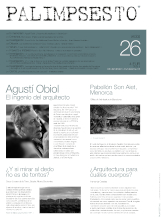Castellano
DOI:
https://doi.org/10.5821/palimpsesto.26.12386Abstract
This paper highlights the need to create better ways of relating people, buildings and the environment. The text centers on the importance of responding to the particularities of different bodies and integrating the elements that define our substance, frequently not visible in architecture, such as water and resources. This research addresses the influence of domestic reformers, who, more than a century ago, fought for ways to reduce domestic labor burdens and invented a new architecture in order to save time and gain freedom. The text links social changes to transformations in the design of spaces, furniture, clothing and ways of lives. It promotes the use of abstract spaces and the need to give relevance to what is visually not fixed or prescribed in order to facilitate personal forms of appropriation. The possibility of change begins with the briefs that determine architectural programs. This study addresses different examples of collective dwelling and highlights the importance of using architectural descriptions to help elaborate the transformations that society demands. Using as an example the patios of Luis Barragán, Mathias Goeritz and Mies van der Rohe and Lilly Reich as well as the cooperative housing projects of Kalkbreite and Zwicky-Süd in Switzerland, the importance is placed in experimentation and in the need to relate the different elements of a project that are repeatedly considered foreign to architecture. In conclusion, the research highlights the need to reduce formal considerations in architecture and address the effects of buildings on people´s lives and on the territory.
Downloads
Published
Issue
Section
License
PROTECTION AND INTELLECTUAL PROPERTY CRITERIA
Authors whose work is published in en Palimpsesto agree to the following terms:
1. The author retains the copyrights and guarantees the magazine the right to apply a Creative Commons Attribution-NonCommercial-NoDerivatives (CC BY-NC-ND), which permits others to share the work with acknowledgement of authorship.
2. The author may establish additional agreements of his or her own accord for non-exclusive distribution of the article published in the magazine (for example, in an institutional repository, or published in a book).
3. Electronic distribution of the work by the author(s) is permitted and encouraged (for example, in institutional repositories or on the author’s own website), prior to, and during the submission process, as this can generate productive exchanges, as well as earlier and greater citation of the published works (see The Effect of Open Access) (in English).
4. The author or provider of the material submitted for publication authorizes Palimpsesto to publish, with no obligation whatsoever (financial or otherwise) to the content of said material, be it in paper or digital format, or in any other medium.
5. The author or provider guarantees that he or she is the owner of the Intellectual Property rights to the contents provided, which encompasses the text and images/photographs/photographic works incorporated in the article.
6. The author or provider, exempts Palimpsesto magazine of all and any responsibility relating to violation of copyrights, thereby committing himself or herself to undertaking all efforts to assist Palimpsesto magazine in defence of any accusation, extra-judiciary, and/or judicial measures. Likewise, the author or provider will assume payment to Palimpsesto of any sum or compensation that must be paid to third parties for failure to comply with these obligations, be it the result of judicial, arbitrary or administrative decisions.
7. The submission of the texts by authors implies automatically a declaration of non plagiarism of its contents







